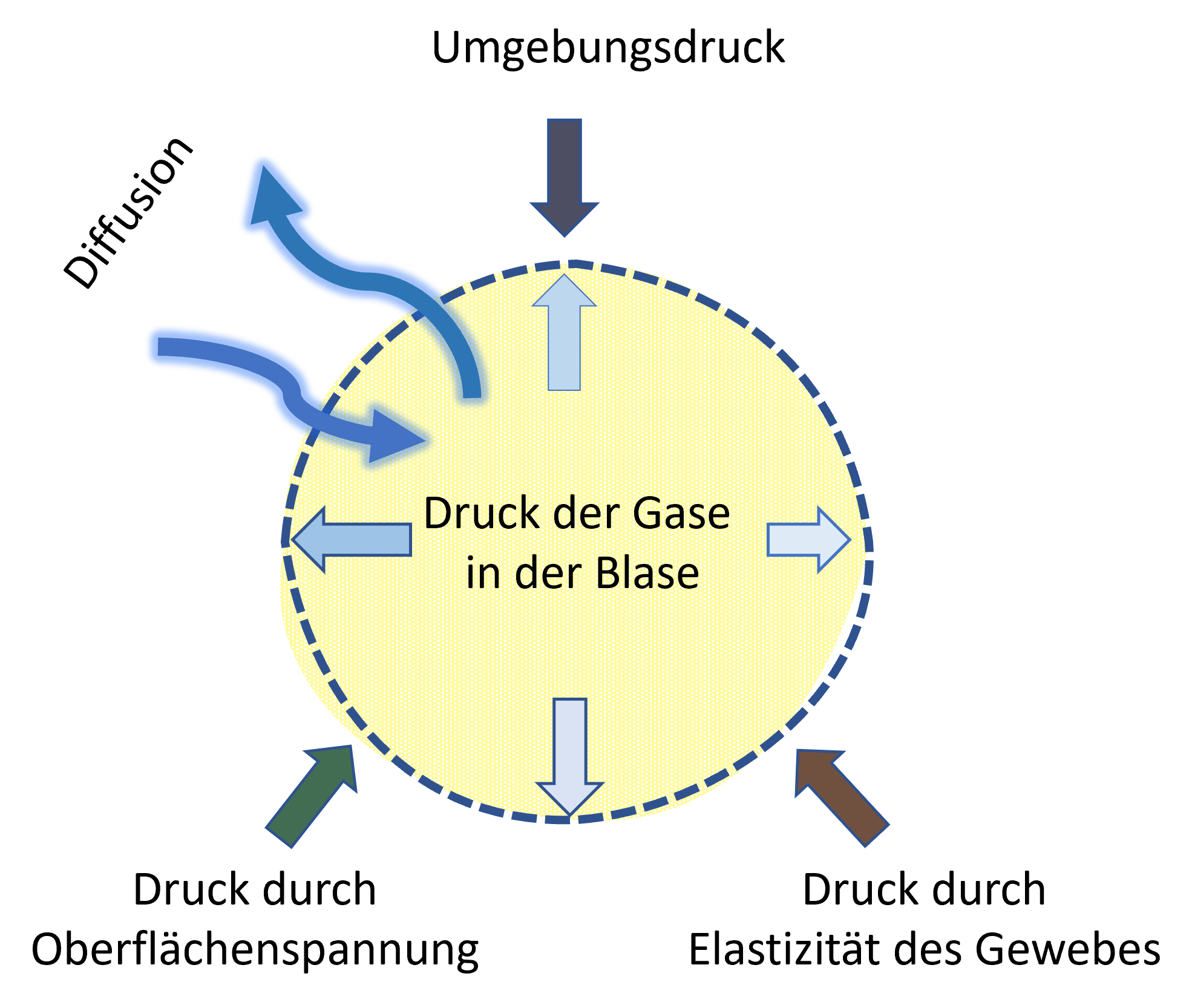Bubbles and bubble models
We have already seen how nitrogen (just like other inert gases) can enter and leave body tissues. It was discussed that a major problem is the formation of gas bubbles, which can occur when tissues are supersaturated. But exactly when bubbles arise and what their further development might look like remained vague. This is what this chapter is about – and about the models that attempt to incorporate bubbles.
Gas bubbles in the body
How do bubbles form?
Bubbles in the real human body are a rather complicated matter, and it is still not really fully understood when and why they develop. If it doesn’t have to be a whole person in full complexity, then the behavior of bubbles in liquids and with pressure changes can be modeled quite well.
A gas bubble in the body occurs when individual gas molecules are no longer dissolved in the surrounding fluid, in the blood plasma or in a tissue, but together form a visible accumulation of free gas. Possible locations for the formation of such blisters are, for example, the peripheral body tissues, from where they could also enter the bloodstream. However, bubbles can probably also form directly in the venous and sometimes even in the arterial circulation.
They probably primarily develop from microbubbles that are already present before the dive and tend to sit in the small bumps in the blood vessels. When these accumulate and dissolve with more free gases, they become gas bubbles, which can then grow and migrate through the body.
What exactly does such a bubble look like?
We start again with a very simplified picture. There are naturally free gases inside the bladder. Not only nitrogen, but also water vapor, CO2, oxygen and, if it becomes more technical, helium can play a role. This is important, even if we often simply think of “nitrogen bubbles” in simplified representations. These gases are under a certain pressure, and this must be slightly higher than the ambient pressure for a bubble of stable size. This is because the contact surface of the bubble with the liquid has a certain tension (the surface tension), which leads to additional pressure on the gas volume. This pressure caused by the surface tension depends on the one hand on specific properties of the surface, but also increases the more the surface is curved, i.e. the smaller the bubble is. This will become important later on. To put it simply, the bubble remains stable if the pressure inside is as high as the combined pressure contribution from the surface tension and the ambient pressure. If the gas bubble is located in a moving, elastic medium, for example, this elasticity of the tissue can also contribute to the pressure. This should suffice as an initial idea, even if we will see below that such a highly simplified picture alone will not lead us to our goal.
The contact surface with the liquid allows the exchange of gas particles with the environment via diffusion that we are already familiar with. The surface of a bubble in a liquid is not a dense skin, but in the simplest case only the boundary between two materials – e.g. the blood plasma and the gases. A layer of molecules can form at the edge of the bubble, which are attracted to water on the outside and repelled by water on the inside.
Such a boundary is basically permeable, or “permeable”: gas particles can pass through it to a certain extent.

Bubble models
VPM-B
In addition to desaturation via blood flow towards the lungs and diffusion, the bubble models attempt to understand the dynamics of the bubbles in the body, the conditions under which they can grow, and also how this growth can possibly be inhibited. And they try to incorporate this understanding into the calculated exchange profiles. This is no easy task. Empirically, the bubble models are not yet demonstrably superior to the neo-Haldane models we are already familiar with in terms of the probability of DCS. It could even be that in some cases the profiles proposed by the bubble models available to date have disadvantages. However, as research is also progressing in this area, and a key for improvement might be turned in the lock at some point, we would like to give these models the attention they deserve.
Want to know more? You can find the complete explanation in our webinars and in our decotheory book!
